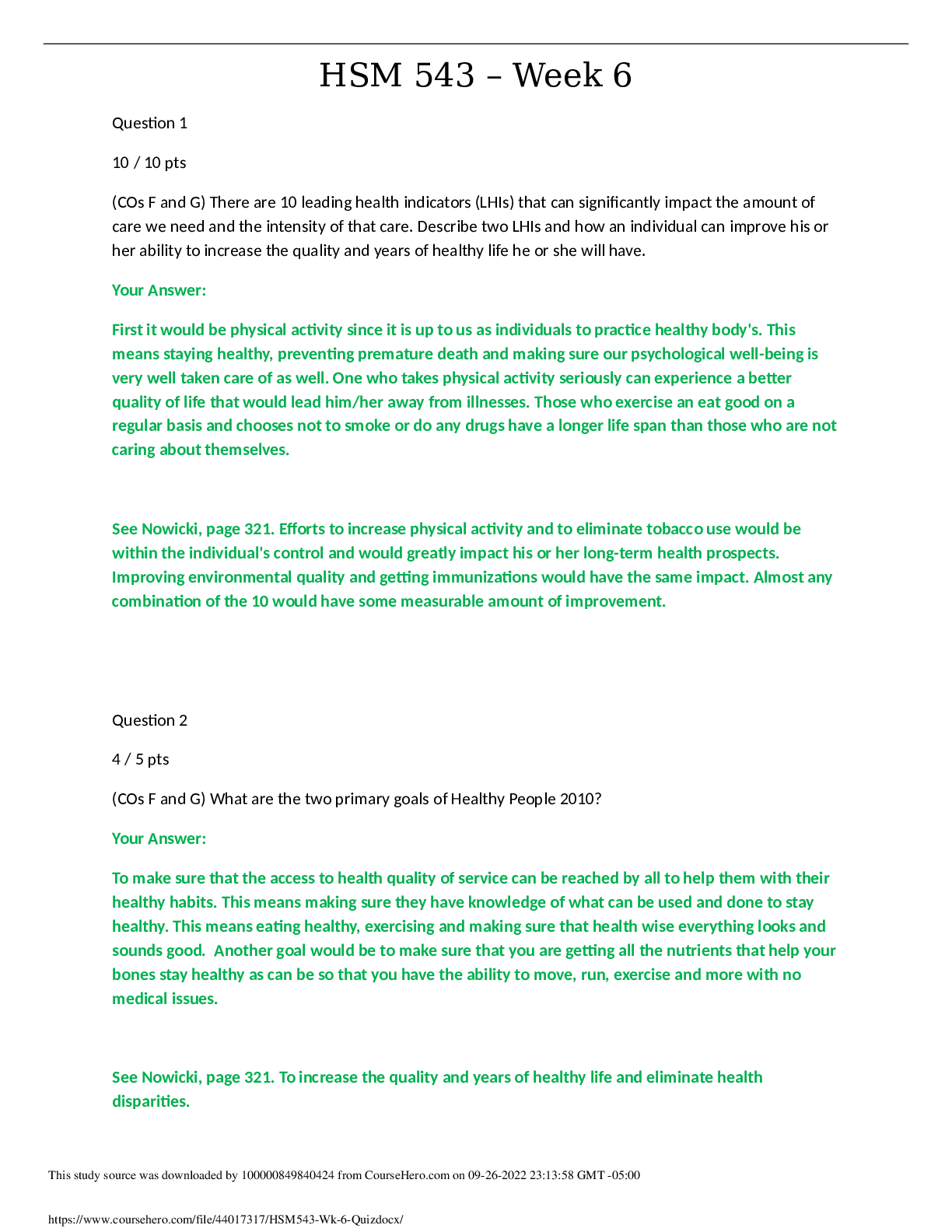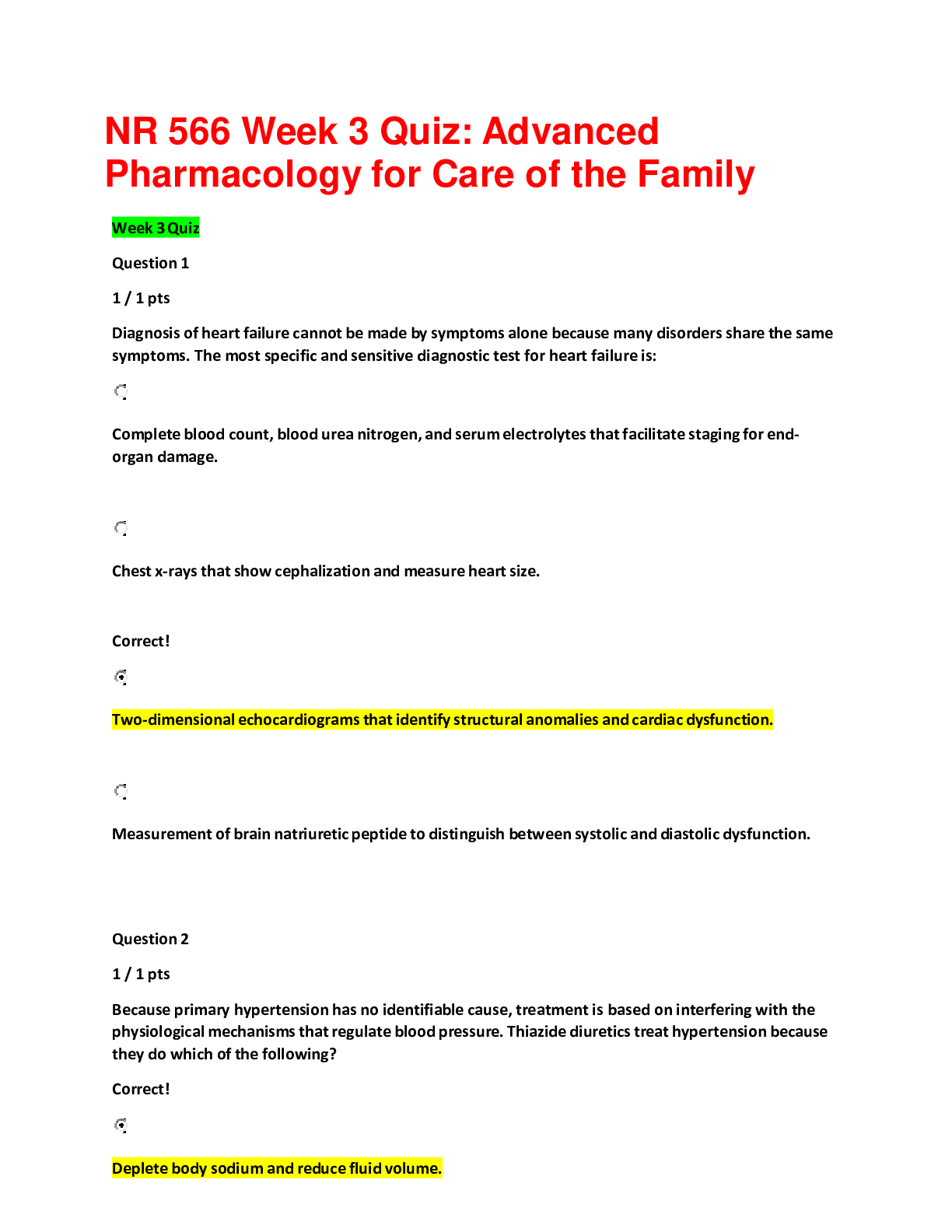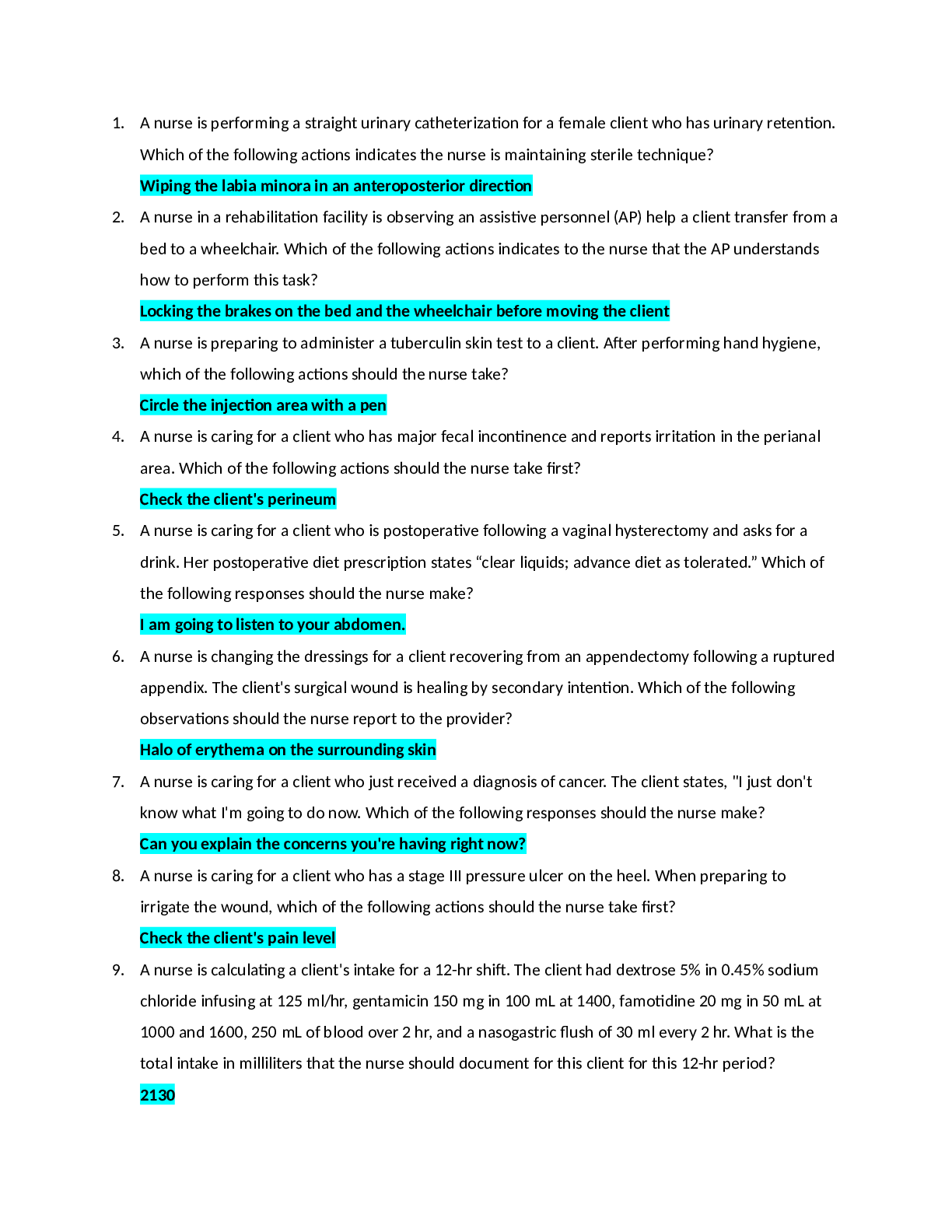NURS nurs 615 Pharm Exam 3 Review with Transcript | Download To Score A
Document Content and Description Below
NURS nurs 615 Pharm Exam 3 Review with Transcript This is the review for exam number three will go week by week and start with the questions from the study guide let's begin Week number eight 1... . Differentiate between low dose and high-dose colchicine. Low dose colchicine is 1.2mg followed by 0.6mg one hour later or 1.8 milligrams total and high dose colchicine is 1.2mg followed by 0.6mg every four to six hours for 4.8mg total. The difference between the two is low dose is as effective as high dose with a lower side effect profile. 2. What lab value should be monitored with gout? Check renal function test, BUN, Creatine 3. What patient education should you provide when prescribing colchicine? Always causes seven degree of diarrhea so make sure that people understand that 4. What patient teaching will you provide when prescribing febuxostat (Uloric)? Gout may worsen with therapy initially. 5. What are the adverse effects of corticosteroids if administered for six months or more? The main thing you want to worry about is osteoporosis it can also worsen diabetic control and patients should report any tarry black stools or abdominal pain. 6. Why is it important to tapper the corticosteroid? Tapering must be done carefully to avoid both recurrent activity of the underlying disease process and possible cortisol deficiency resulting from the hypothalamic-pituitary-adrenal axis or HPA suppression during the period of steroid therapy 7. What are the black box warnings on NSAIDs? May cause an increased risk of serious cardiovascular thrombotic events, myocardial-infarction and stroke which can be fatal. This first may increase with duration of use. Patients with cardiovascular disease or with risk factors for cardiovascular disease may be a greater risk. NSAIDs can also cause an increased risk of serious gastrointestinal adverse effect adverse events including: bleeding, ulceration, and perforation the stomach or intestines which can be fatal. These events can be our can occur at any time during use and without warning symptoms. Elderly patients are at greater risk for serious GI events. 8. What are the recommendations in the treatment of pain? You want to start with NSAIDs first and then work your way up from there. 9. What's the mechanism of action of ibuprofen? NSAIDs such as ibuprofen work by inhibiting the cox-2 enzymes cox which is cyclooxygenase is officially known as the prostaglandin-endoperoxide synthase (PTGS), which converts arachidonic acid to prostaglandin h2 or PGH2. PGH2 in turn is converted by other enzymes to several other prostaglandins which are mediators of pain inflammation and fever and to thromboxane-A2 which stimulates platelet aggregation leading to the formation of blood clots. It's a good idea to familiarize yourself with the cox pathway and how blocking one part of the cox pathway can lead to build up of other different other products. The exact mechanism of action of ibuprofen is unknown. Ibuprofen is a non-selective inhibitor of cyclooxygenase, its pharmacological effects are believed to be due to inhibition of cox-2 which decreases the synthesis of prostaglandins in mediating the inflammation pain fever and swelling. Antipyretic effects may be due to action on the hypothalamus resulting in an increase of peripheral blood flow, basil dilation, and subsequent heat dissipation. Inhibition of cox-1 is thought to cause some of the side effects of ibuprofen including GI ulceration like aspirin and indomethacin, ibuprofen is a non-selective cox-2 inhibitor in that it inhibits two isoforms of psychological oxygenase cox-1 and cox-2. The analgesic and antipyretic and anti-inflammatory activity of NSAIDs appear to operate mainly through inhibition of cox-2 resident. Inhibition of cox-1 would be responsible for the unwanted effects on the GI tract. However, the role of individual cox isoforms in the analgesic and anti-inflammatory and gastric damage effects of NSAIDs is uncertain and different compounds cause different degrees of analgesia and gastric damage. Ibuprofen is also a reversible inhibitor of the cox pathway. On the other hand, aspirin is a non-reversible inhibitor of the cox pathway. 10. What are serious side effects associated with acetaminophen? Today the mechanism of action of acetaminophen is not completely understood. The main mechanism is performed a proposed is the inhibition of cox. And recent findings suggest that it's highly selective cox-2 and because of its selectivity for cox-2 it does not significantly inhibit the production of pro clotting thromboxanes. While it has analgesic and antipyretic properties compared to those of aspirin or other NSAIDs its peripheral anti-inflammatory activity is usually still limited by several factors. One of which is the high level of peroxides present and inflammatory lesions and in some circumstances even the peripheral anti-inflammatory activity comparable to NSAIDs can be observed. Acute overdoses of acetaminophen can cause potentially fatal liver damage. In 2011 the FDA launched a public education program to help consumers avoid overdose, warning it can cause serious liver damage if more than directed is used. The maximum recommended dose is 4 grams in 24 hours. Week Nine 1. Identify symptoms of hypoglycemia, hyperglycemia and ketoacidosis. Hypoglycemia can be shown by dizziness, confusion, diaphoresis, and tachycardia. Hyperglycemia is seen with polyuria, polydipsia, and weight loss. DKA or diabetic ketoacidosis you get a fruity breath odor, and rapid respirations. Neurologic symptoms including lethargy, focal sign, and obtundation can develop this can progress to coma in later stages. 2. How does metformin work? Metformin is major effect is to decrease hepatic glucose output by inhibiting gluconeogenesis. In addition, metformin increases insulin mediated glucose utilization peripheral tissues such as the muscle and liver particularly after meals and has a antilipolytic effect that lowers serum phreatic concentrations thereby reducing substrate availability for gluconeogenesis it's also used in diabetics to decrease their cholesterol and triglyceride levels. 3. What diagnostic testing is required before and throughout therapy with metformin? Metformin is not metabolized. It is cleared from the body via tubular secretion and excreted unchanged in the urine. You should order a serum creatinine to assess for impaired renal function. 4. What is the action of gliptin? Inhibitors Dipeptidyl peptidase-4 (DPP4), or dpp-4 inhibitors or gliptins, are a class of oral hypoglycemics that block DPP-4. They can be used to treat diabetes mellitus type. The first agent in the class, sitaglipin, was approved by the FDA in 2006. Glucagon increases blood glucose levels and dpp-4 inhibitors reduced glucagon blood glucose levels. Mechanism of the dpp-4 inhibitors is to increase incretin levels which inhibit glucagon release which in turn increases insulin secretion, decreases gastric emptying, and decreases blood glucose levels. 5. How do GLP agonists work? Glucagon-like peptide-1 receptor agonist also known as glp-1 receptor agonist or incretin mimetics are agonists of the GLP-1 receptor. This class of drugs is used for treatment of type 2 diabetes one of their advantages over older insulin secretagogues such as sulfonylureas are meglitinides is that they have a lower risk of causing hypoglycemia. They bind to glucagon-like peptide-1 receptors slowing gastric emptying, increasing insulin secretion by pancreatic beta cells. Simultaneously the compound reduces the elevated glucagon secretion by inhibiting alpha cells of the pancreas which is known to be inappropriate in the diabetic patient. GLP-1 is normally secreted by L cells of the gastro intestinal mucosa response to a meal. 6. When should exenatide be administered? Exenatide is a synthetic version of exendin-4 hormone found in the saliva of the Gila monster. It displays biological properties similar to human glucagon-like peptide-1 or GLP-1 a regulator glucose metabolism and insulin secretion. Exenatide enhances glucose-dependent insulin secretion by the pancreatic beta-cell, suppresses inappropriately elevated glucagon secretion and slows gastric emptying although the mechanism of action is still under study. It should be administered 60 minutes before breakfast and dinner. 7. What are the adverse effects of propylthiouracil or PTU? PTU inhibits the enzyme thyroperoxidase, which normally acts in thyroid hormone synthesis by oxidizing the anion iodide (I−) to iodine (I0), facilitating iodine's addition to tyrosine residues on the hormone precursor thyroglobulin. This is one of the essential steps in the formation of thyroxine (T4). PTU does not inhibit the action of the sodium-dependent iodide transporter located on follicular cells' basolateral membranes. Inhibition of this step requires competitive inhibitors, such as perchlorate and thiocyanate. Side effects include fatal granulocytopenia which usually the first sign is a fever and sore throat, vasculitis, a temporary alopecia, rash, aplastic anemia, and acute renal failure. 8. What are the adverse effects of levothyroxine? Levothyroxine is a synthetic thyroid hormone that is chemically identical to levothyroxine T4 Which is naturally secreted by the follicular cells of the thyroid gland. It is used to treat thyroid hormone deficiency and occasionally to prevent the recurrence of thyroid cancer. Like it's naturally secreted counterpart levothyroxine is a chiral compound in the L form. Adverse effects include tachycardia and angina, more notably in the elderly 9. A patient develops toxic goiter. What's the recommended treatment? Methimazole inhibits the enzyme thyroperoxidase, which normally acts in thyroid hormone synthesis by oxidizing the anion iodide (I−) to iodine (I2), hypoiodous acid (HOI), enzyme linked hypoiodate (EOI) facilitating iodine's addition to tyrosine residues on the hormone precursor thyroglobulin, a necessary step in the synthesis of triiodothyronine (T3) and thyroxine (T4). It is used to treat hyperthyroidism in patients with toxic adenoma or toxic goiter in preparation for more definitive therapy with radioiodine or surgery. So short answer Methimazole. 10. What are the adverse effects of PTU and Methimazole? Methimazole is teratogenic and in the fetus can cause aplasia cutis which is a congenital focal absence of the skin on the scalp you should look at some pictures of this is quite striking. Adverse effects of PTU include agranulocytosis anca positive vasculitis, hepatotoxicity, and pancreatitis which is rare. 11. What is the dosage schedule for alpha-glucosidase inhibitors? The primary one that people deal with is called acarbose. It is available in fifty and a hundred milligram tablets and should be taken with the first bite of each meal. We usually begin with 50 milligrams three times daily. Flatulence, diarrhea, and abdominal discomfort are dose-related and almost always resolve if the dose is decreased—few people tolerate more than 300 milligrams daily and is contraindicated in patients with inflammatory or irritable bowel syndrome. 12. Skipped 13. What is the mechanism of action of propylthiouracil? It works in the thyroid as well as peripherally. In the thyroid PTU inhibits the thyroperoxidase which normally acts and thyroid hormone synthesis by oxidizing the iodide to iodine we've talked about that several times. PTU does not inhibit the action of sodium-dependent iodine transporter on the follicular cells these lateral membranes. So actions at the t3 and t4 target tissues. PTU also acts by inhibiting the enzyme 5-deiodinases which converts t4 to the active form t3. This is in contrast to mithemazole all which shares propylthiouracil central mechanism but not it’s peripheral one. So Mademoiselle only work centrally in the thyroid. PTU works both essentially in the thyroid as well as the target tissues. It's important to recognize that these enzymes only work in conjugated tyrosine molecules of t3 and t4 a completely different enzyme family that is responsible for the deiodinase activity of iodinase single tyrosine molecules within the thyroid follicular cells. 14. What are the contraindications for therapy with alpha-glucosidase inhibitors? Patients with irritable or inflammatory bowel syndrome is cannot take them second-degree to the flatulence that they can produce. 15. What patient education is important relative the administration of levothyroxine? Take on an empty stomach approximately half an hour before meals as such thyroid replacement therapy is usually taken 30 minutes prior to eating in the morning. 16. What black box has the FDA issued regarding administration of TZDs (thiazolidinediones)? The main side effect of TZDs is water retention leading to edema generally a problem in less than five percent of individuals but a big problem for some and potentially with significant water retention leading to a decompensation of potentially unrecognized heart failure. Therefore, TZDs should be prescribed with both caution and patient warnings about the potential for water retention and weight gain especially in patients with decreased ventricular function. In 2011, the FDA announced that TZD use the more than one year may be associated with an increased risk of bladder cancer and two months later the label was updated with an additional warning about this risk. (That’s Actos.) 17. What symptoms may indicate that a patient is taking too much thyroid replacement hormone? You'll see symptoms of hyperthyroidism, tachycardia, insomnia or nervousness. 18. What is the mechanism of action of it metformin? We've already discussed this. 19. What lab values will be used to monitor a patient on levothyroxine? Blood free thyroxine and TSH levels are monitored to help determine whether the dose is adequate. This is done four to eight weeks after the start of treatment for a change in dose. Once the adequate replacement dose has been established the test can be repeated after six and then 12 months unless there is a change in symptoms. Week Number Ten 1. What is the onset of action peak of action and duration of action of each insulin preparation? Tt's good to just know all of these there if you just search the insulin preparation chart. There's a nice chart that shows when each one goes up and when they go down and that's another way to kind of visualize how the insulins work. Rapid-acting insulins like Lispro, Aspart, and Glulisine. The onset is about five minutes and a peek at one hour, duration of about four or five hours. Short acting or regular insulin is sometimes used around mealtime, taken about 30 to 45 minutes before eating. It peeks in three to four hours, and duration is four to 10 hours. Intermediate acting like NPH is mixed with protamine delaying absorption. Insulin looks cloudy and has to be mixed before injected. Its onset is 1 to 1-1/2 and hours; peak of 4 to 10 hours, and duration of 12 to 24 hours. Long acting like Glargine or Levemir(detemir) insulins on set 2 to 4 hours; duration 24 hours with little or no peak. On the chart it just was like this, just kind of goes like this (makes a line with his hand) such as the steady state without changing for 24 hours. 2. When changing from NPH to Glargine insulin, how will you adjust the patient's dose? Insulin glargine is a long-acting basal insulin analog given once daily to help control blood sugar levels of those with diabetes. It consists of microcrystals it slowly releases insulin giving a long duration of action of 18 to 26 hours with the people's profile. Pharmacokinetic it resembles basal insulin secretion of a non-diabetic pancreatic beta cells. The initial dose of glargine is reduced by twenty percent to avoid hypoglycemia. 3. What are the side effects of insulin therapy? Most common is hypoglycemia. Hypokalemia can also result. 4. What assessment should be made before prescribing in any antihypertensive agent? You should check a thorough assessment of their liver and renal function. The real function especially for ace inhibitors and ACE receptor blockers which are primarily in the kidneys. 5. Why are ACE inhibitors the drug of choice and diabetic patients with hypertension? They reduce the adverse effects of diabetes on the kidneys. ACE inhibitors slow the onset of diabetic nephropathy in patients with microalbuminuria and type 1 diabetes. In the Micro-Hope trial patients with diabetes and one cardiac respect were studied. Subjects were titrated to a 10mg day of Ramipril or a placebo the study was stopped prematurely because of the significant decrease and combined primary outcomes in patients taking Ramipril total cardiovascular end points reduced by twenty-five percent these included myocardial infarction, stroke, cerebrovascular death, total mortality, and revascularization in reported neuropathy. 6. What's the most common adverse effect of ACE inhibitors? A dry, hacking cough. That's the most common reason to change treatment from an ace inhibitor to an ace receptor blocker. 7. What is the mechanism of ACE inhibitors? They work in the region Angie attention angiotensin syndrome. I posted a really good review of the renin-angiotensin system and the announcements from the American Academy of family practitioners. I would take a very close look at it was especially one chart that goes over like all the different steps and were each of them work. The renin angiotensin system is systemically and locally driven. The systemic process is triggered by the kidneys response to decreased effective blood volume and begins with the secretion of insulin from the renal cortex. Once released renin cleaves off angiotensinogen to form an Angiotensin-I. This product in turn is catalyzed by angiotensin converting enzyme or ACE formed primarily in the pulmonary vasculature and angiotensin-II. This potent basil constrictor effects tissues and systems throughout the body, research shows that these basil constrictor effects are attenuated by ACE inhibition. So again a review table one of the AFP article on ACE inhibitors. 8. What is the mechanism of action of angiotensin receptor blockers? Again refer to the PDF in the announcements. 9. What is the mechanism of action of calcium channel blockers? In the body's tissues the concentration of calcium ions outside the cells is normally about ten thousand fold higher than the concentration inside the cells. Embedded in the membrane of some cells are calcium channels and these cells receive a certain signal the challenge open letting calcium rush into the cell. The resulting increase in intracellular calcium has different effects on different types of cells. Calcium channel blockers prevent or reduce the opening of these channels and thereby reduce the effects. Voltage-dependent calcium channels are responsible for excitation, contraction, coupling of skeletal smooth and cardiac muscle, and for regulating aldosterone in cortisol secretion in the end of them cells of the adrenal cortex. In the heart they are also involved in conduction of pacemaker signals. Calcium channel blockers are used as medications they primarily have four effects: (1) by acting on vascular smooth muscle they reduce contraction the arteries and causes an increase in arterial diameter a phenomenon called vasodilatations. Calcium channel blockers do not work on Venus smooth muscle; (2) by acting on cardiac muscles or the myocardium they reduce the force of the contraction of the heart; (3) by slowing down the conduction of electrical activity within the heart they slow down the heart rate; (4) and by blocking calcium signal on adrenal cortex cells they reduce aldosterone production which collaborates with lower blood pressure. Since blood pressure is an intimate feedback with cardiac output in peripheral resistance with relatively low blood pressure the afterload on the heart decreases and this decreases how hard the heart pumps and heart muscle must work to eject blood into the aorta. So the amount of oxygen required by the heart decreases accordingly. This can help ameliorate symptoms of ischemic heart disease such as angina pectoris. There are classes of calcium channel blockers. Calcium channel blockers known as dihydropyridines which includes nifedipine and nicardipine they mainly affect arterial vascular smooth muscle and lower blood pressure by causing vassal dilation. The phenylalanine class of calcium channel blockers such as verapamil mainly affect the cells of the heart and had negative inotropic and negative chronotropic effects. So negative inotropic how strong the heart muscle works and negative chronotropic how quickly it beats. The benzothiazepine class of calcium channel blockers like Diltiazem combined effects of the two other classes. 10. What are the adverse effects of dihydropyridine-type calcium channel blockers? DHP-calcium channel blockers so again DHP ones are like nifedipine and nicardipine there are derived from the molecule dihydropyridine and often used to reduce systemic vascular resistance and arterial pressure. Sometimes when they were used to treat angina the vasodilation and hypertension can lead to a reflex tachycardia which can be detrimental for patients with the ischemic symptoms because the resulting increase in myocardial oxygen demand. If you remember the dihydropyridine type calcium channel blockers only work on the vasculature and do not work on the heart. These channel calcium channel blockers can worsen proteinuria with patients with neuropathy which can increase edema and the hands and feet. 11. What are the side effects of the calcium channel blockers? We just discussed this in question number 10. 12. What are the adverse effects of statins? Statins, which are also known as hmg-coa-reductase inhibitors, are a class of lipid lowering medications that inhibit the enzyme hmg-coa-reductase which plays a central role in the production of cholesterol. High cholesterol levels have been associated with cardiovascular disease. Statins have been found to reduce cardiovascular disease and mortality in those who are at high risk. Most evidence suggests that statins are effective in preventing heart disease and those with high cholesterol but no history of heart disease. A 2013 Cochrane review found it decreasing risk of death and other poor outcomes without any evidence of harm for every hundred and thirty-eight people treated for five years one fewer dies and for every 49 treated one fewer has an episode of heart disease. A 2011 review reach similar conclusions. Stanczyk by competitively inhibiting hmg-coa-reductase the first enzyme of the malonate pathway. Because statins are similar in structure to hmg-coa on a molecular level they will fit into the enzymes active site and compete with the native substrate which is hmg-coa this competition reduces the rate by which hmg-coa- reductases is able to produce malonate the next molecule in the cascade that eventually produces cholesterol. By inhibiting hmg-coa-reductase statins block the pathway for synthesizing cholesterol in the liver this is significant because most select circulating cholesterol comes from an internal manufacturer rather than diet in the liver can no longer produce cholesterol levels of cholesterol blood will fall. Cholesterol synthesis appears to occur mostly at night so statins with short half-lives are usually taken at night to maximize their effects. Main side effect that you have to look out for this class of drugs is rhabdomyolysis; you can also see an increased risk of diabetes and increase the liver enzymes the blood due to liver damage. Other possible adverse effects include cognitive loss, neuropathy, pancreatic and other hepatic dysfunction and sexual dysfunction 13. What patient education would you provide for client in which you have prescribed a statin? Instruct the patient to report any muscle weakness or tenderness and dark urine to the provider immediately. 14. What lipid disorders do fibric acids derivatives treat? They mainly treat elevated triglycerides. Fibrates are used as an accessory therapy in many forms of hypercholesterolemia usually in combination with statins. Clinical trials do support their use as monotherapy agents. Fibrates reduce the number of nonfatal heart attacks but do not improve all-cause mortality and therefore are indicated in those not tolerant to statins. Although less effective in lowering LDL and triglycerides levels the ability of fibrates to increase HDL and lower triglyceride levels seems to reduce insulin resistance when the dyslipidemia is associated with other features of a metabolic syndrome like hypertension and diabetes type II. They are therefore used in many hyperlipidemias. Fibrates are not suitable for patients with low HDL levels. 15. What lipid disorders do bile acid sequestrants treat? Cholestyramine or trade names, Cholybar; Olestyr is a bile acid sequestrants which binds bile in the GI tract to prevent its reabsorption. It's a strong ion exchange resin which means they can exchange it chloride anions with anionic bile acids in the GI tract and bind them strongly in the resin matrix. The functional group of the anion exchange resin is a quaternary ammonium group attached to an inert styrene divinylbenzene copolymer. Cholestyramine removes bile acids from the body by forming insoluble complexes with bile acids in the intestine which are then excreted in the feces. As a result of this loss of bile acids or plasma cholesterol is converted to bile acids in the liver to normalize levels. This conversion of cholesterol in a bile acid lowers plasma cholesterol levels. 16. What would you recommend to a patient who is experiencing flushing with niacin therapy? Niacin, also known as vitamin B3 or nicotinic acid, is an organic compound with the formula CA and is what one of the 20 to 80 essential human nutrients. Pharmaceutical and supplemental niacin are primarily used to treat hypercholesterolemia and pellagra which is niacin deficiency. The main side effect is flushing which usually last for 15 to 30 minutes, although it can sometimes last up to two hours. It's sometimes accompanied by prickling or itching sensation in particular in areas covered by clothing. So that flushing can be blocked by taking 300 milligrams of aspirin a half an hour before taking niacin. Week Eleven 1. How is amlodipine metabolized? It's metabolized in the liver to inactive metabolites vs cyp3a4; grapefruit juice inhibits the cyp3a4 or 384 increasing the amount of amlodipine in the bloodstream. 2. What are the side effects of amlodipine? Amlodipine is a medication used to treat high blood pressure and prevent chest pain; it can also be used for heart failure. It is a long-acting dihydropyridine calcium channel blocker. By widening blood vessels, it lowers blood pressure. In angina, it increases blood flow to the heart muscle to relieve pain due to angina. Adverse side effects to the use of amlodipine include which are common there are three main types the first is common and dose-related can see peripheral edema, dizziness and palpitations, and flushing; common not dose-related: include fatigue, nausea, abdominal pain, and somnolence; and rare side effects include: blood disorders, impotence, depression, insomnia, tachycardia, gingival enlargement, hepatitis, and jaundice. 3. What patient teaching will you provide when prescribing amiodarone? In the eye: side effects include corneal micro deposits and optic neuropathy can occur. So any visual problems using amiodarone definitely see the doctor or provider right away. Skin: you can see a bluish-gray discoloration of the skin and photosensitivity so make sure that your patients use sunscreen. Lung: you can see some interstitial lung disease. You can see both hypo and hyperthyroidism and they should monitor their blood pressure daily. 4. What are the drug interactions with digoxin? Digoxin is a purified cardio glycoside similar to digitoxin extracted from the foxglove plant digitalas lanata. Digoxin is occasionally used in the treatment of various heart conditions namely atrial fibrillation, atrial flutter, and sometimes heart failure that cannot be controlled by other medication. The most common indication for digoxin are a fib and a flutter with that rapid ventricular response although beta blockers and calcium channel blockers are a better first choice. There is tentative evidence that digoxin may increase the risk of death though another meta-analysis reports no change in mortality. High ventricular rate leads to insufficient diastolic filling time. By slowing down the conduction of the AV node and increasing its refractory period digoxin can reduce the ventricular rate. The arrhythmia insult was not affected but the pumping function of the heart improves owing to improve filling. Digoxin has potentially serious interactions with verapamil, amiodarone, erythromycin, and epinephrine as would be injected by a local with a local in the anesthetic. The digoxin level should be monitored while taking albuterol; need to monitor renal functions as it's excreted in the kidneys. Here's a little bit of history about digoxin and often described but really seen adverse effect of digoxin is to disturbance of color vision mostly yellow and green called tritanopia. Vincent van Gogh's “yellow period” may have been influenced by concurrent digitalis therapy. 5. What's the purpose of thyroid panel with amiodarone? Induced abnormalities in thyroid function are common. Amiodarone is structurally similar to thyroxine which contributes to the effects of amiodarone on thyroid function. Both under and over activity of the thyroid may occur on amiodarone treatment. Treatment of free thyroxine alone may be unreliable in detecting these problems and thyroid stimulating hormone should therefore be checked every six months or TSH should be checked every six months. 6. What is nitrate tolerance? Nitroglycerin is used for the treatment of angina, acute myocardial infarction, severe hypertension, and coronary artery spasms. In the short run, Glyceryl Trinitrate can cause severe headaches and an algesic administration for relief of pain; severe hypotension; and in certain cases bradycardia. This makes some providers nervous and should prompt caution when starting nitrate administration. The painful nature of these adverse effects has marked negative impact on patient compliance. Tolerance, is the attenuation or loss of one or several the effects of organic nitrates after long-term administration. All organic nitrate regimens using frequent dosing of long acting nitrates (which is about three or more times daily) continuous delivery symptoms transdermal nitroglycerin patches, or continuous IV infusions of nitroglycerin for the long-acting preparations, will result in partial or complete nitrate tolerance. Here are several proposed mechanisms which may contribute to the development of tolerance including: activation of neuro-hormone mechanisms; plasma volume expansion in the depletion of intercellular self hydro pro-factors. To avoid tolerance to long-term nitrate therapy regimens should be tailored to provide a 10 to 12-hour nitrate-free interval level when possible. This means is that antianginal prophylaxis can only be provided by nitro therapy or nitrate therapy for some portion of each day and that some patients will develop an increase in angina and the nitrate free intervals which will necessitate short-term therapy with sublingual nitroglycerin or a similar preparation. 7. What are the contraindications to Coumadin? Warfarin (brand name Coumadin) is an anticoagulant normally used in the prevention of thrombosis and thromboembolism. Warfarin and related 4-hydroxycoumarin- containing molecules decreased blood coagulation by inhibiting vitamin K epoxide reductase enzyme that recycles oxidized vitamin k to its reduced form after it has participated in the carboxylation of several blood clot blood coagulation proteins. Mainly prothrombin and factor VII. Despite being labeled a vitamin k antagonist Warfarin is not antagonize the action vitamin K or rather antagonizes vitamin K recycling depleting active vitamin K. Thus the pharmacologic action may always be reversed with fresh my vitamin K. When administered these drugs do not anti- coagulate blood immediately, instead onset of their effect requires about two to three days before remaining active-clotting factors that have time to naturally disappear. Metabolism and the duration of a single dose of warfarin is 2 to 5 days. Reversal of warfarin’s effect by discontinuing its use or by administering vitamin K requires a similar period of time. People on warfarin should avoid vitamin K rich foods which include diets high in green leafy vegetables especially kale and spinach. Vitamin K amount these vegetables are more available for absorption if these green vegetables are cooked. So like students vintage cook kale things like that patients on these on warfarin should avoid these. If you search on the internet there are many diets just for Warfarin patients. Warfarin is contraindicated in pregnancy as it passes through the placental barrier and may cause bleeding in the fetus. Warfarin use during pregnancy is commonly associated with spontaneous abortion, stillbirth, neonatal death, and preterm birth. There are also known teratogens in the incidence of birth defects of infants exposed to Warfarin in-utero (to be around five percent although higher figures up to thirty percent have been reported in some studies) depending on when exposure occurs during pregnancy, two distinct combinations of congenital abnormalities can arise. 8. What classes of medications are used in the treatment of congestive heart failure? First-line therapy for people with heart failure used to reduce the systolic function should include angiotensin converting ACE inhibitors or ACE receptor blockers. A person develops a long-term cough as a side effect of the ACE inhibitor. Use of medicines from this class are associated with improved survival and quality of life and people with heart failure. Beta blockers also form part of the first line treatment adding to the improvement in symptoms of mortality provided by ACE inhibitors and ACE receptor blockers. The mortality benefits of beta-blockers and people with systolic dysfunction who also a-fib is more limited to those who do not have a- fib. If the ejection fraction is not diminished the benefits of beta-blockers is modest a decrease in mortality has been observed. A reduction in hospital admission for uncontrolled symptoms has not observed. In people who are intolerant of ACE inhibitors or ARBs or who have significant kidney dysfunction the use of combined hydralazine and a long-acting nitrate such isosorbide nitrate is an effective alternative strategy. This regimen has been shown to reduce mortality and people with moderate heart failure it's especially beneficial in African Americans. In African Americans were symptomatic hydralazine and isosorbide nitrate and be added to an ACE inhibitor or ARB. In people with markedly reduced ejection fraction the use of an aldosterone antagonist in addition to beta blockers and ACE inhibitors can improve symptoms and reduce mortality. Second line drugs for congestive heart failure do not conform mortality benefit. Digitalis is one such drug—its narrow therapeutic window; high degree of toxicity, and the failure in multiple trials to show a mortality benefit has reduced its role included our clinical practice. It is now only used in small number of people with poor fractory symptoms or are in a-fib or have chronic low blood pressure. Diuretics have been a mainstay of treatment for the treatment of fluid accumulation and includes diuretics classes such as loop diuretics, thiazide-like a potassium- sparing diuretics although widely used evidence of their efficacy is safety limited with the effect exception of spironolactone antagonists. A recent Cochrane review found that in small studies use of diuretics appear to have improved mortality in individuals with heart failure however the extent to which these results can be extrapolated to a general population is unclear due to the small number of participants in cited studies. Let's talk about procainamide for a bit there aren't any questions about it but it is covered in your exam. Procainamide is a pharmaceutical anti-arrhythmic agents used for the medical treatment of cardiac arrhythmias classified as 1a. This drug is used for both supraventricular and ventricular arrhythmias. For example, it can be used to convert new onset a-fib though it is sub- optimal for this purpose. To have a high efficacy anti-arrhythmic drug procainamide has to be dosed frequently to maintain an adequate serum concentration. Because of its short half-life it must be dose every three to four hours. Also procainamide induced anti-nuclear antibodies are formed after six months of treatment. There's a close line between the plasma concentration of the therapeutic atopic effect therefore a higher risk of toxicity. There are many side effects following the induction of procainamide. These include: ventricular dysrhythmias, bradycardia, hypotension, and shock. The adverse effects occur even more if the daily doses are increased. Procainamide may also lead to drug induced fever and other allergic responses. There is also a chance the systemic lupus erythematosus can occur, which at the same time leads to polyarthralgia, myalgia, and pleurisy—most of these side effects may occur due to the aestivation of procainamide. That's all the content that is on your exam if you have any specific questions or concerns don't hesitate to contact me, have a good weekend. [Show More]
Last updated: 1 year ago
Preview 1 out of 12 pages
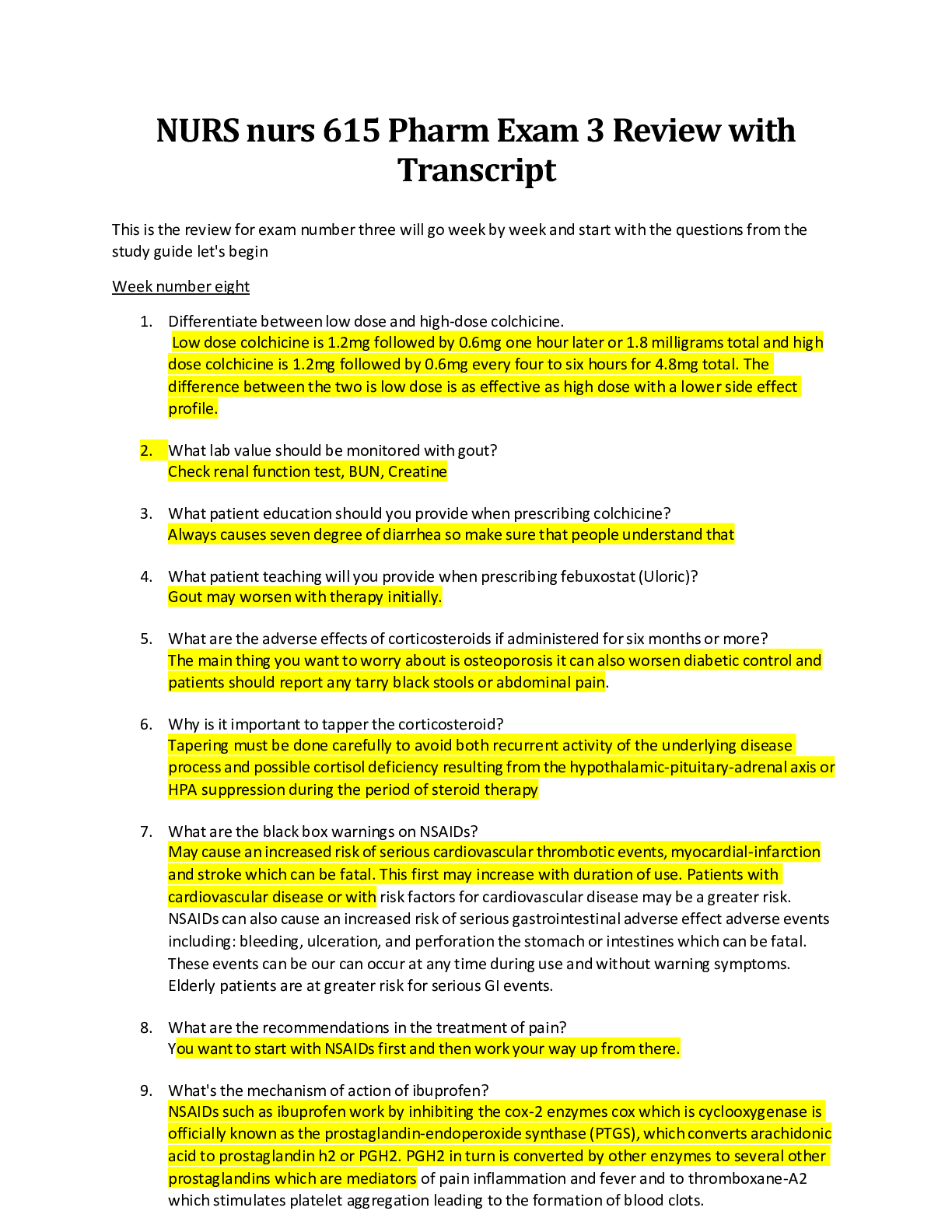
Reviews( 0 )
Document information
Connected school, study & course
About the document
Uploaded On
Sep 20, 2021
Number of pages
12
Written in
Additional information
This document has been written for:
Uploaded
Sep 20, 2021
Downloads
0
Views
52

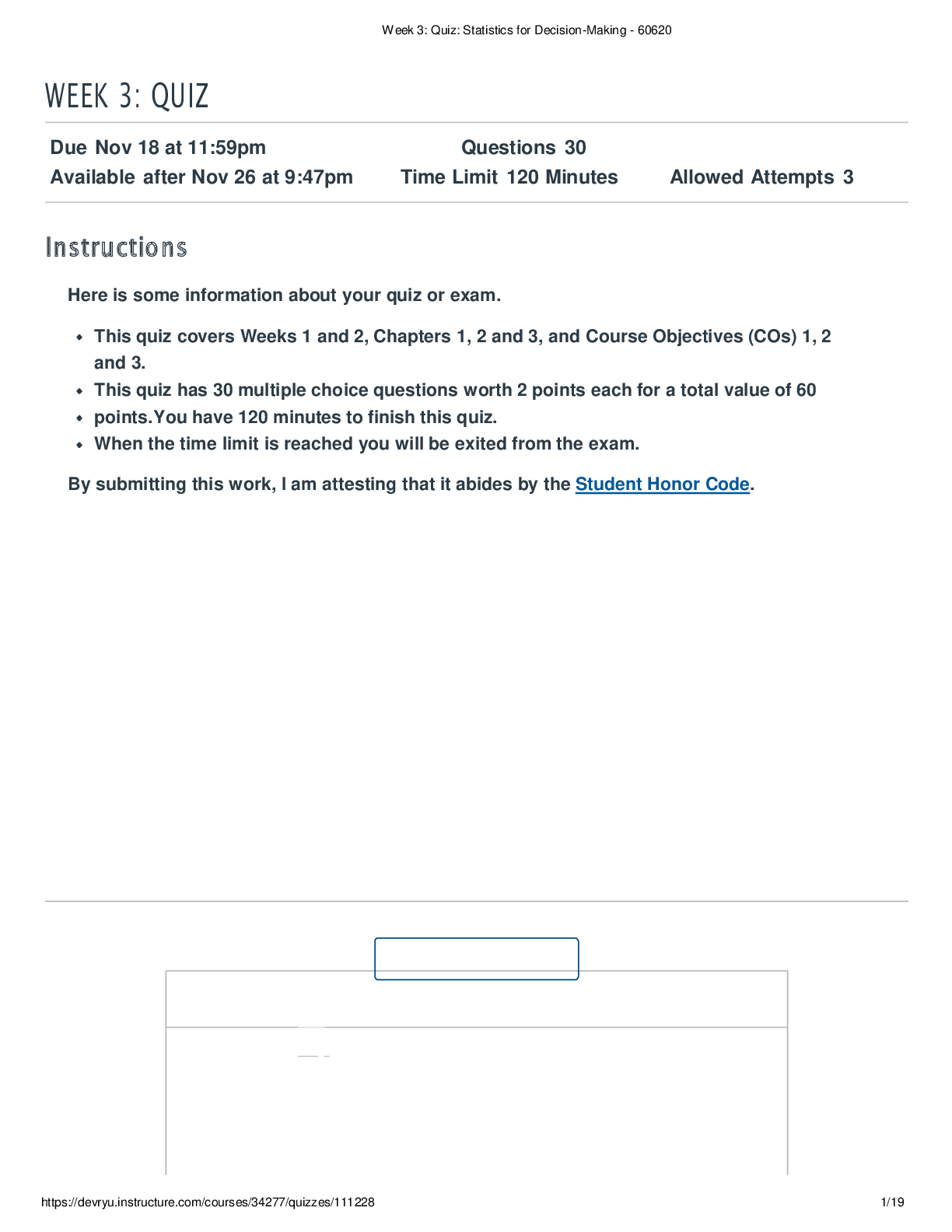

.png)










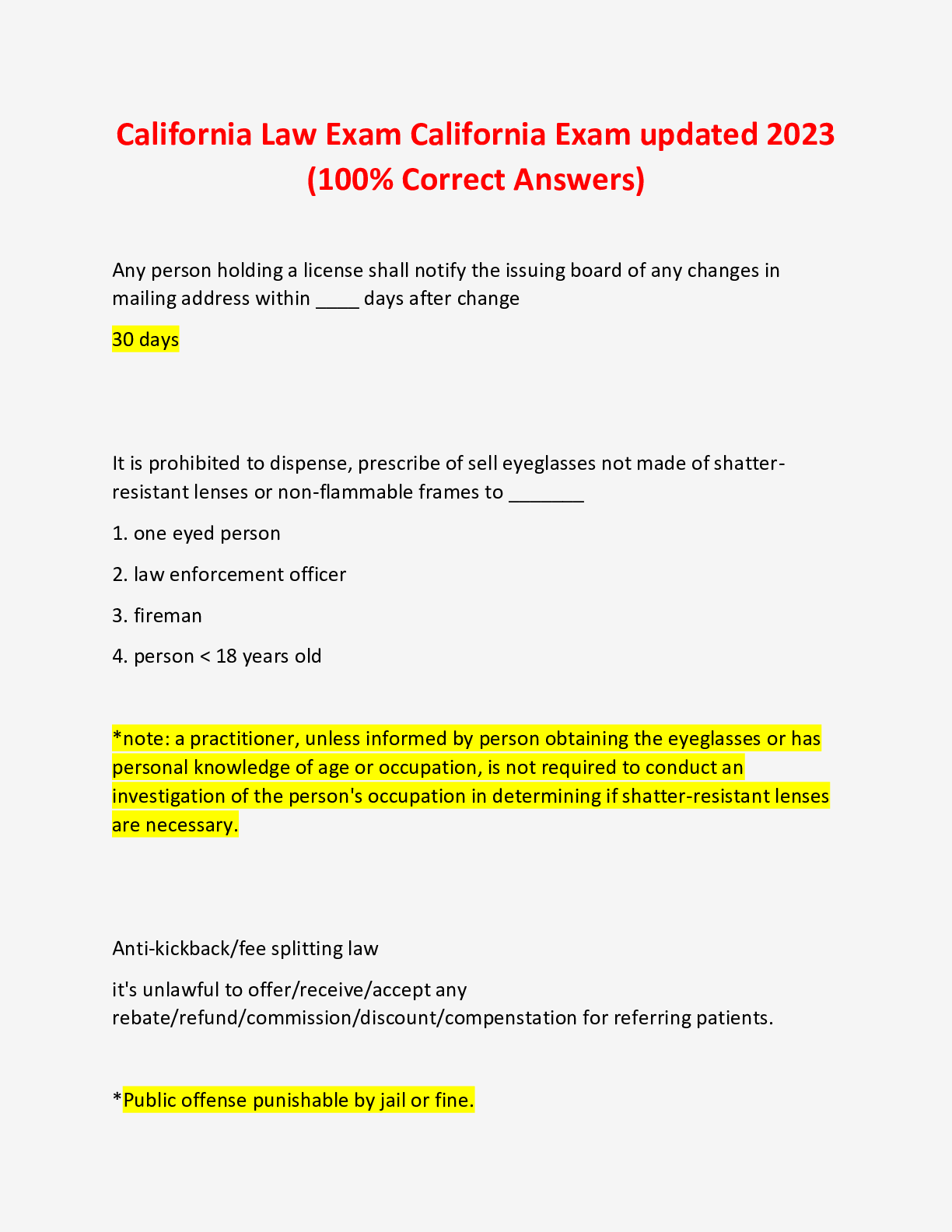




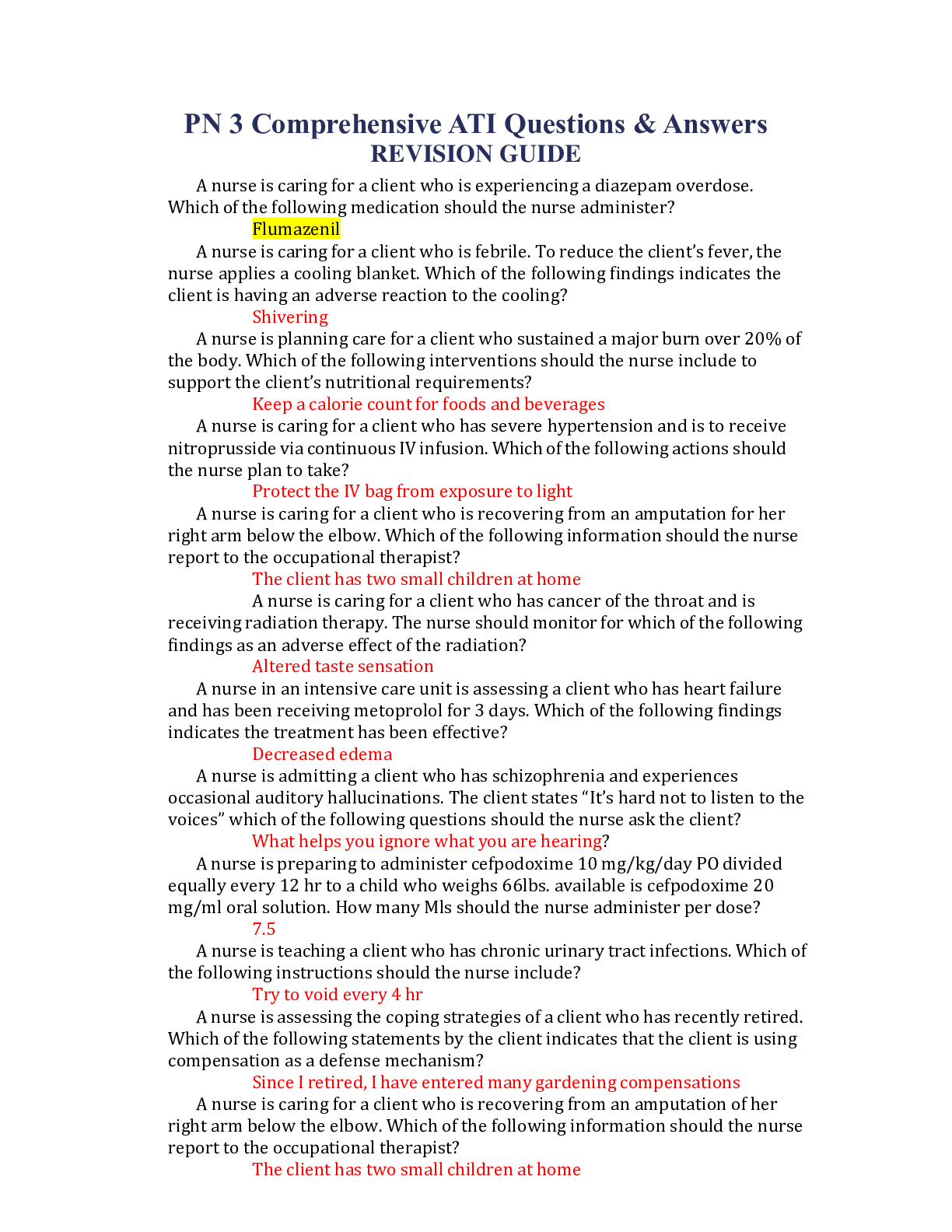
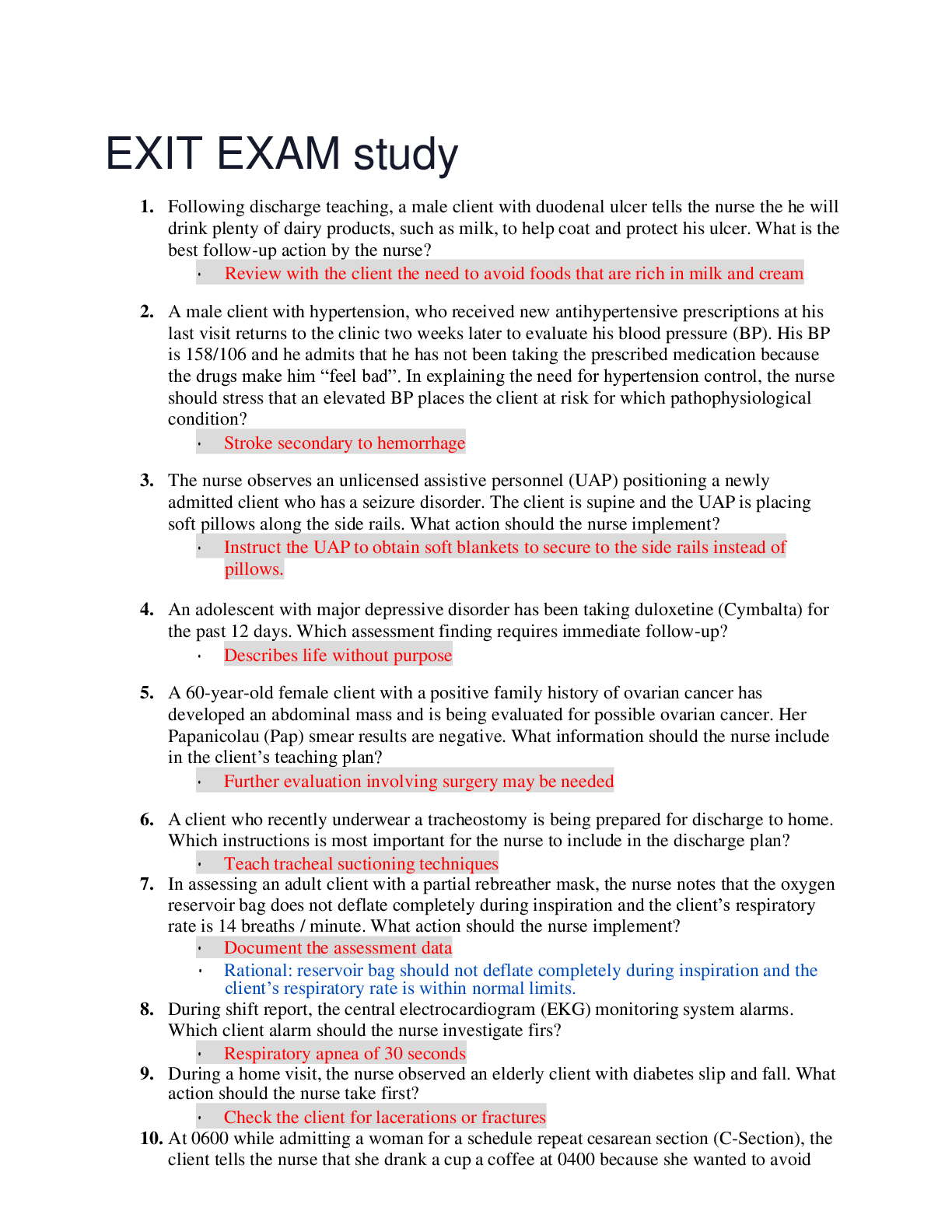
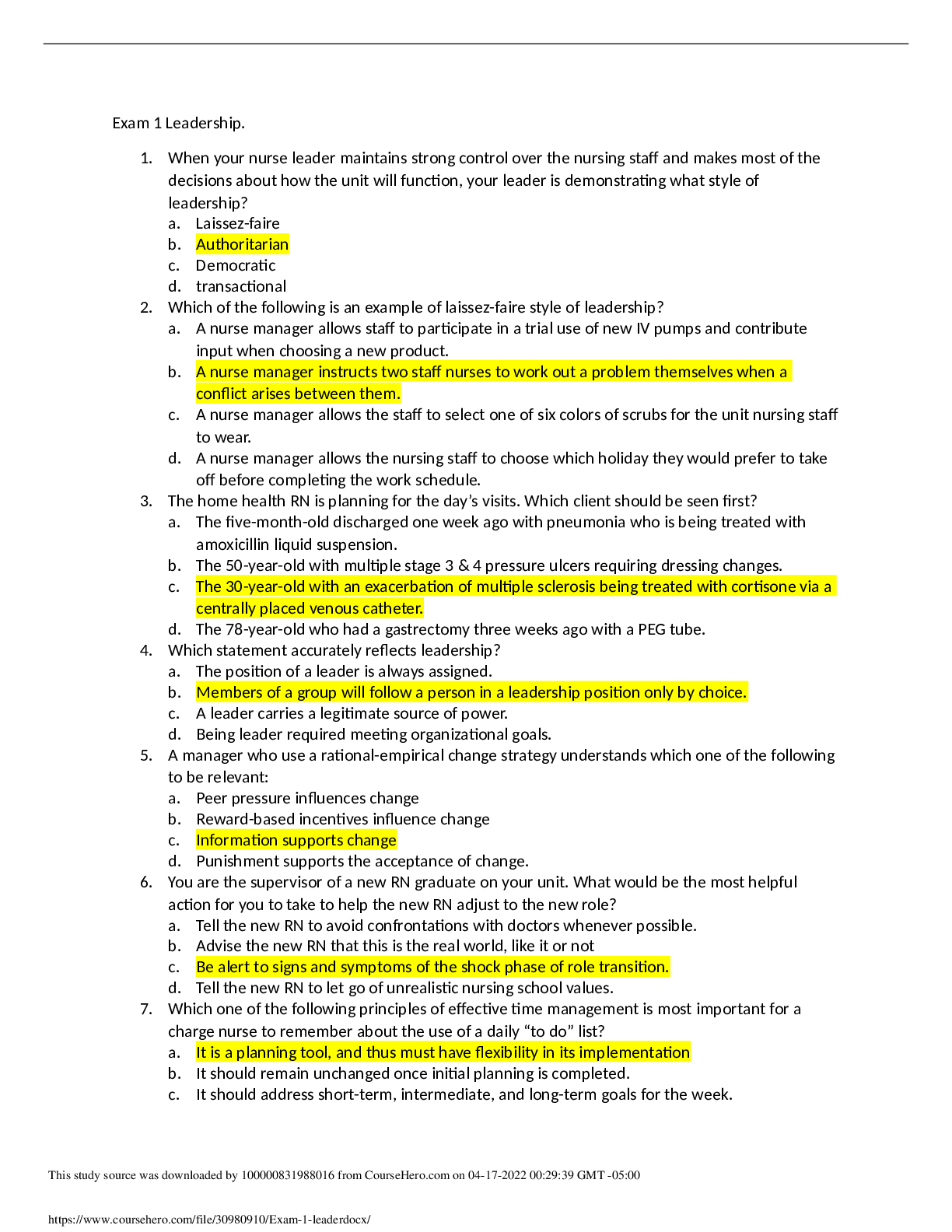
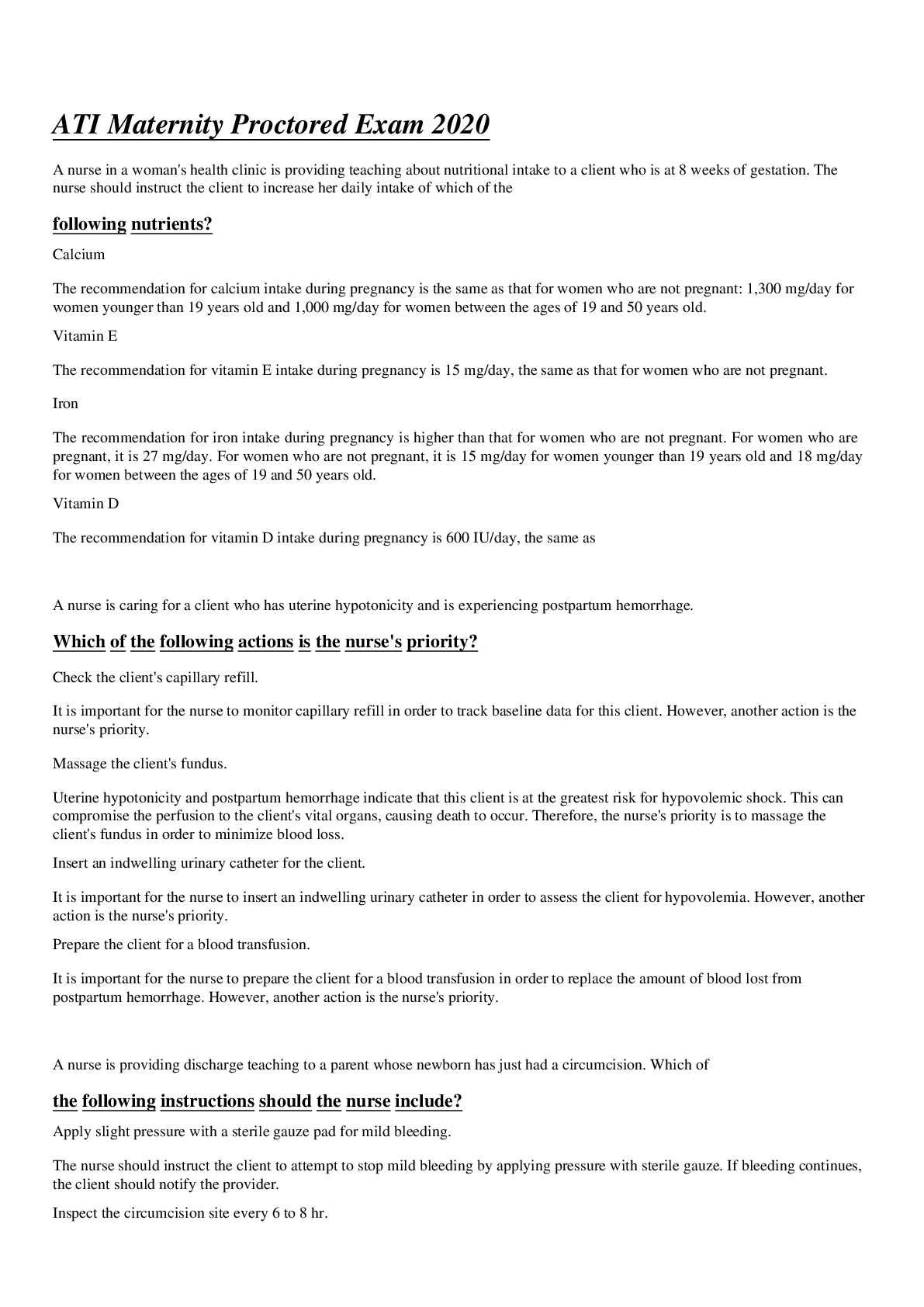
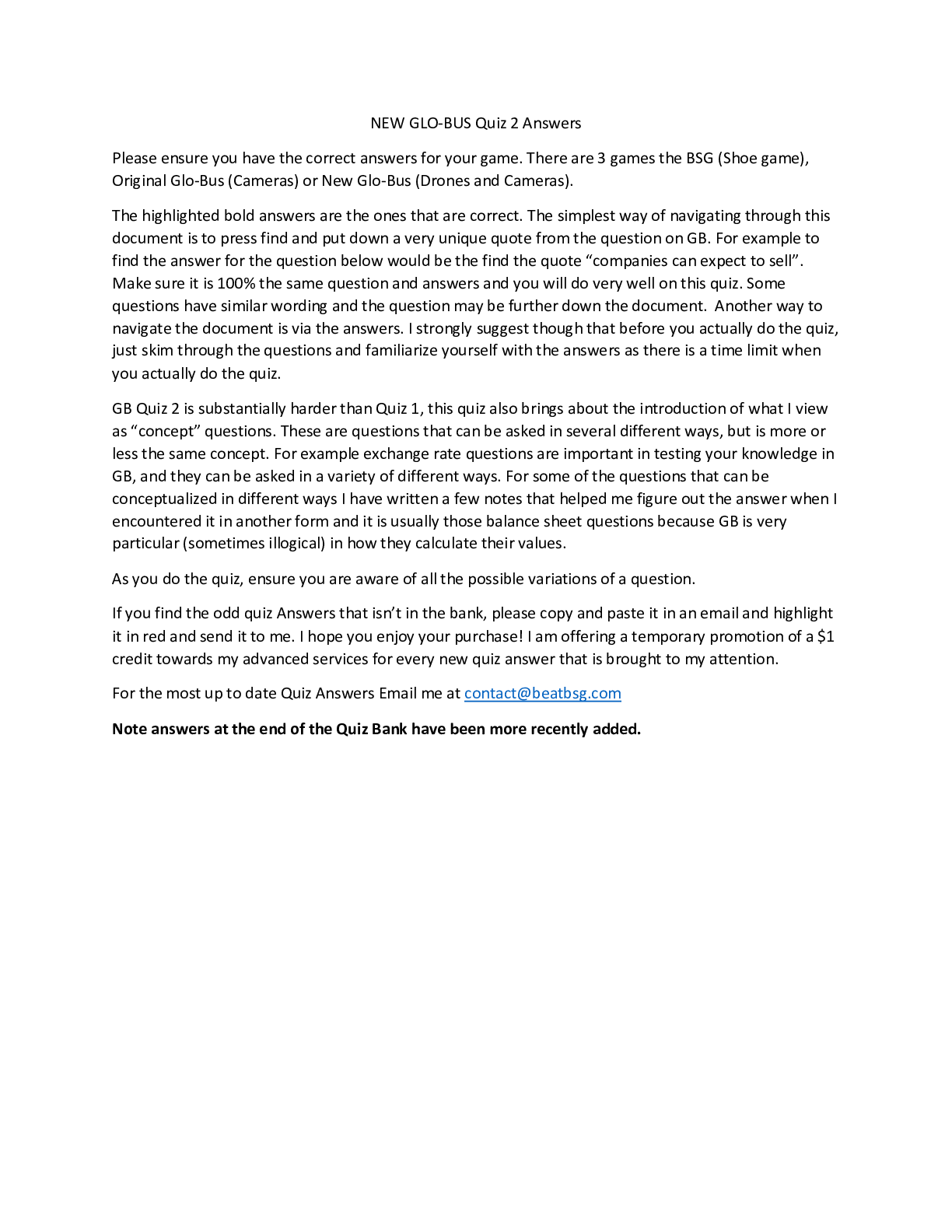
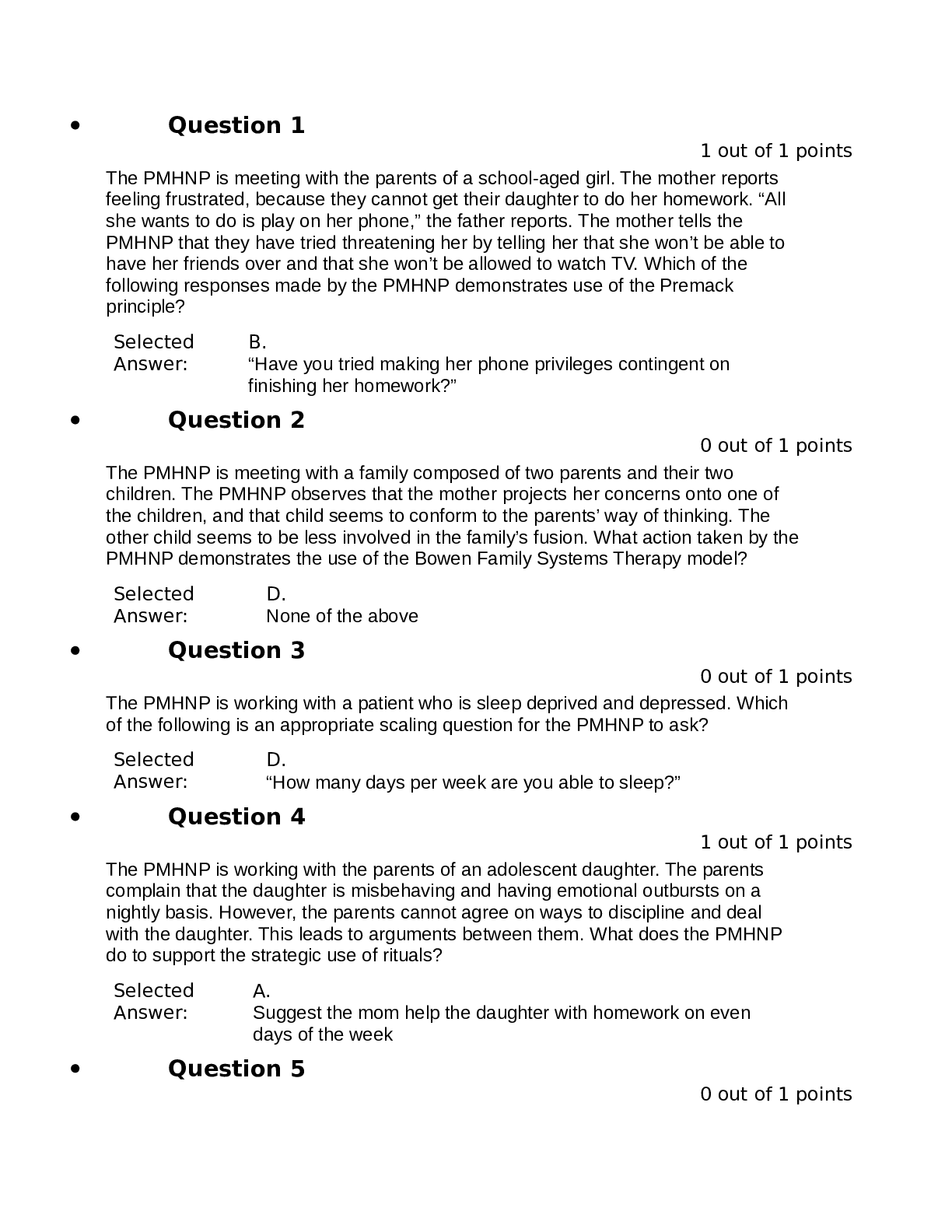
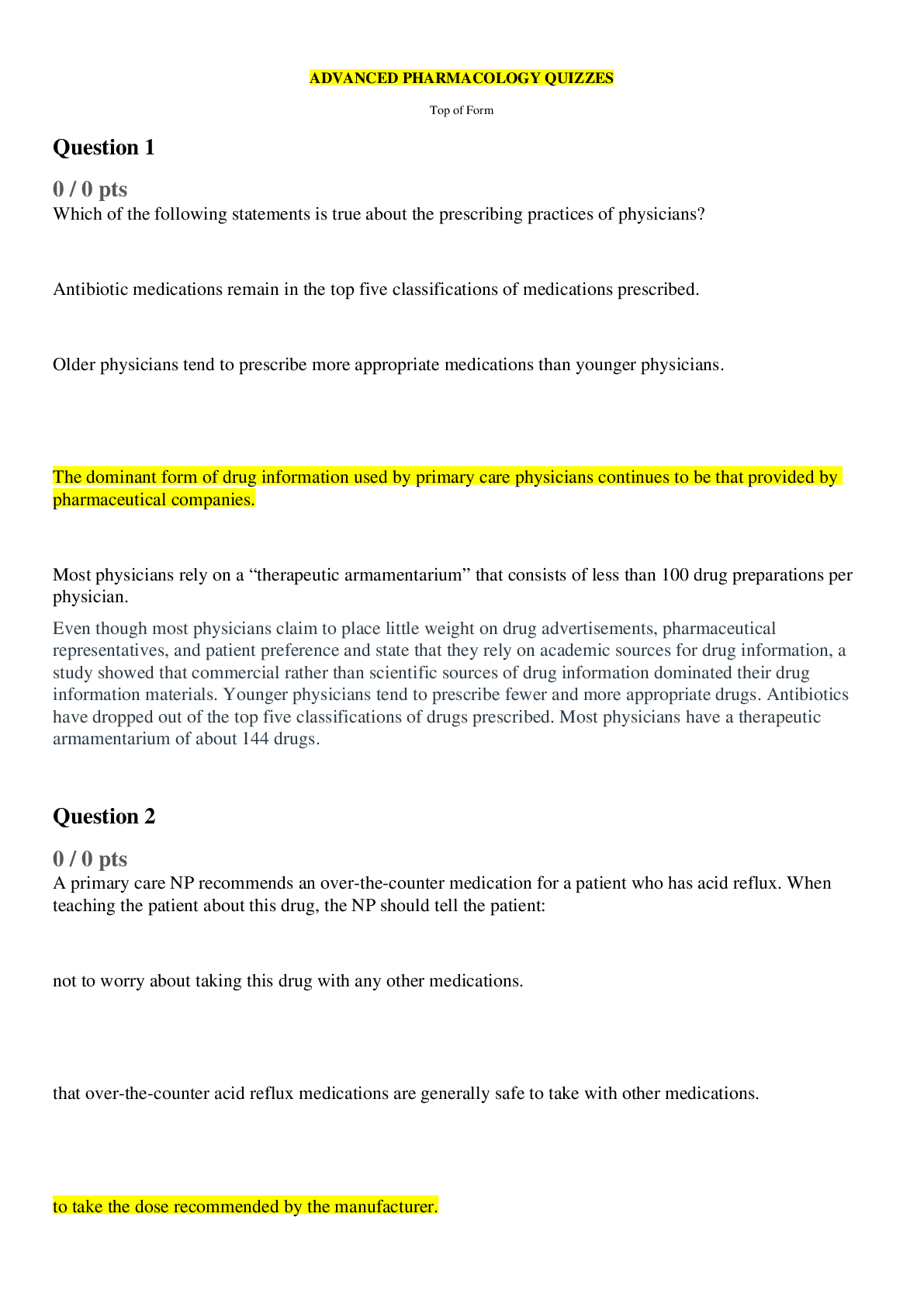
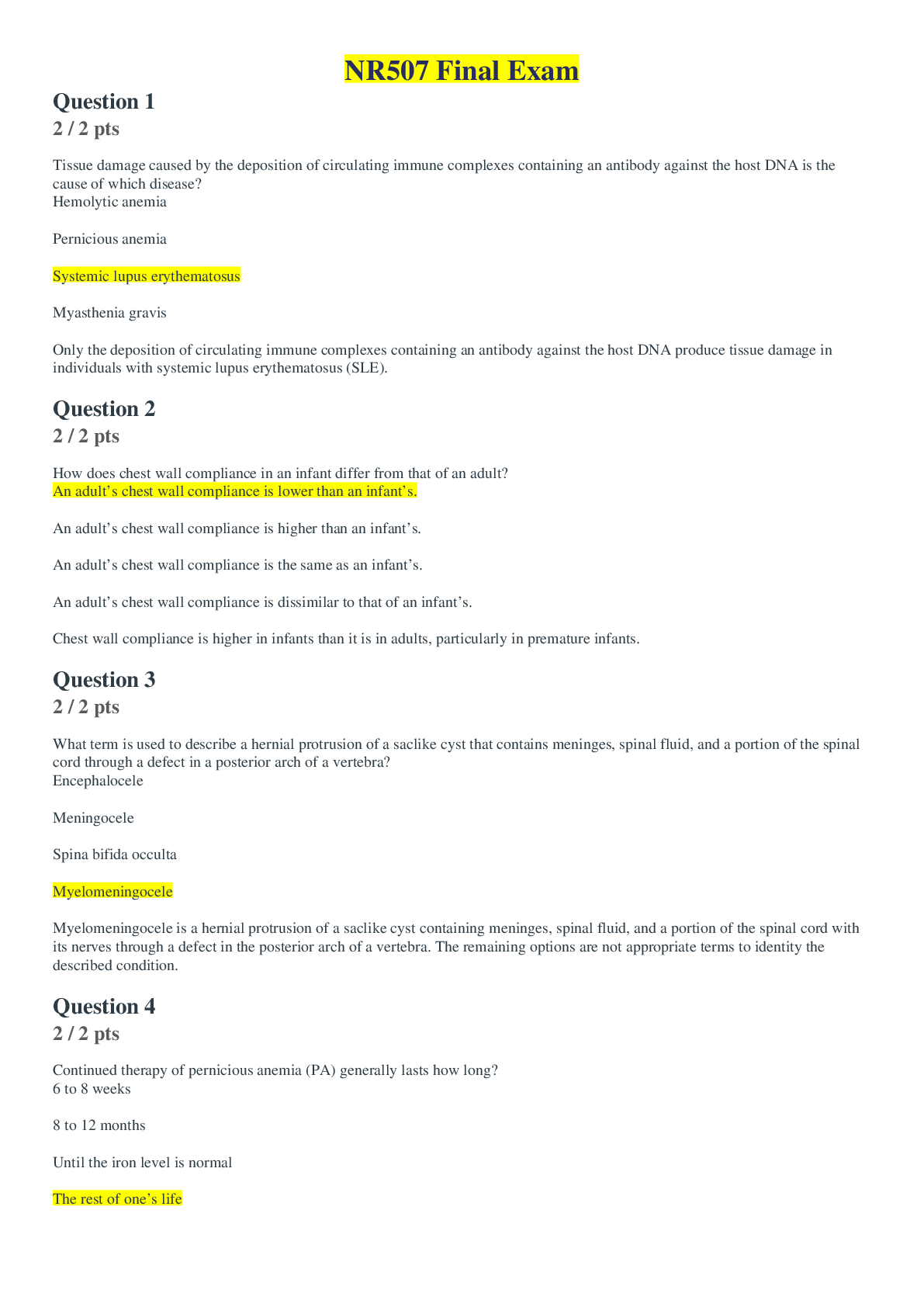
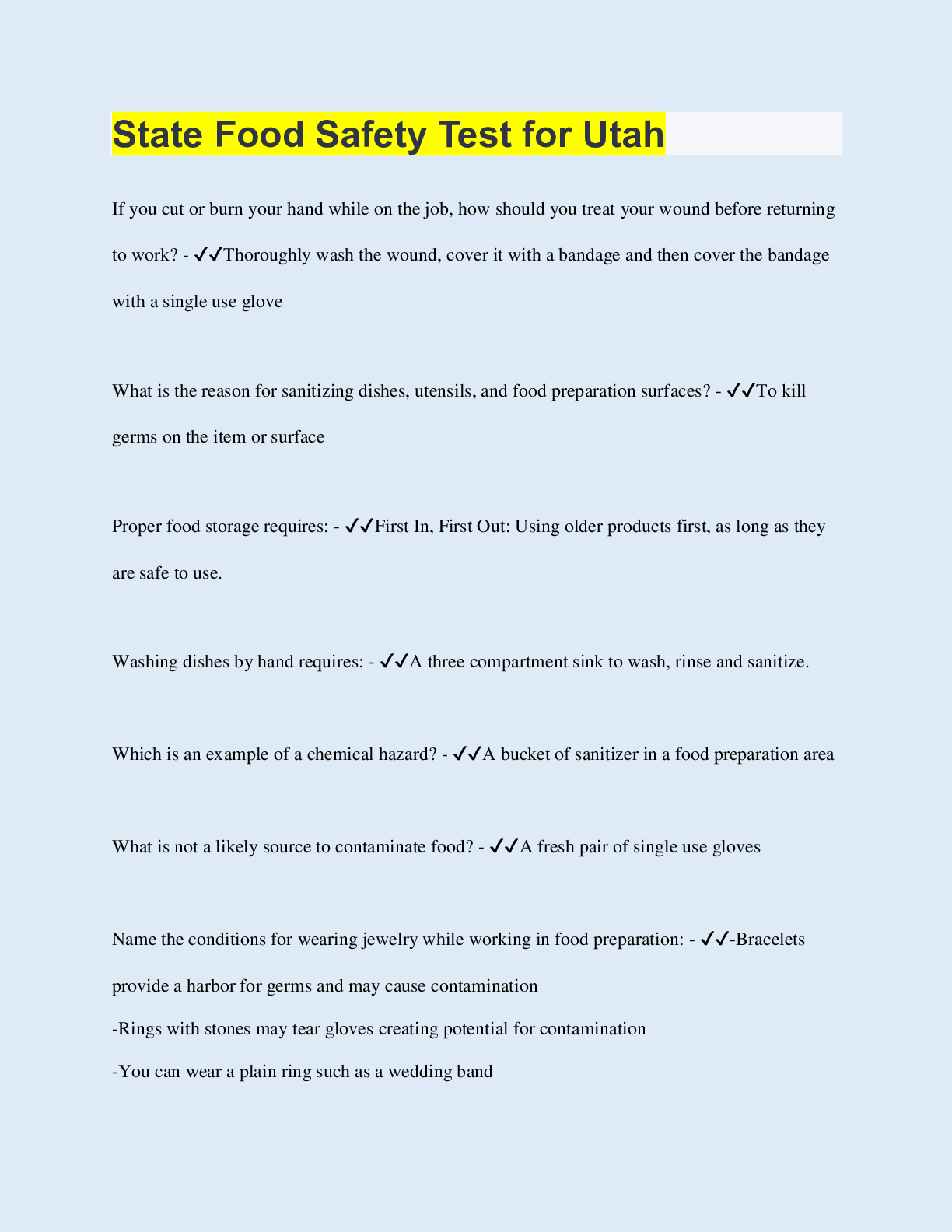

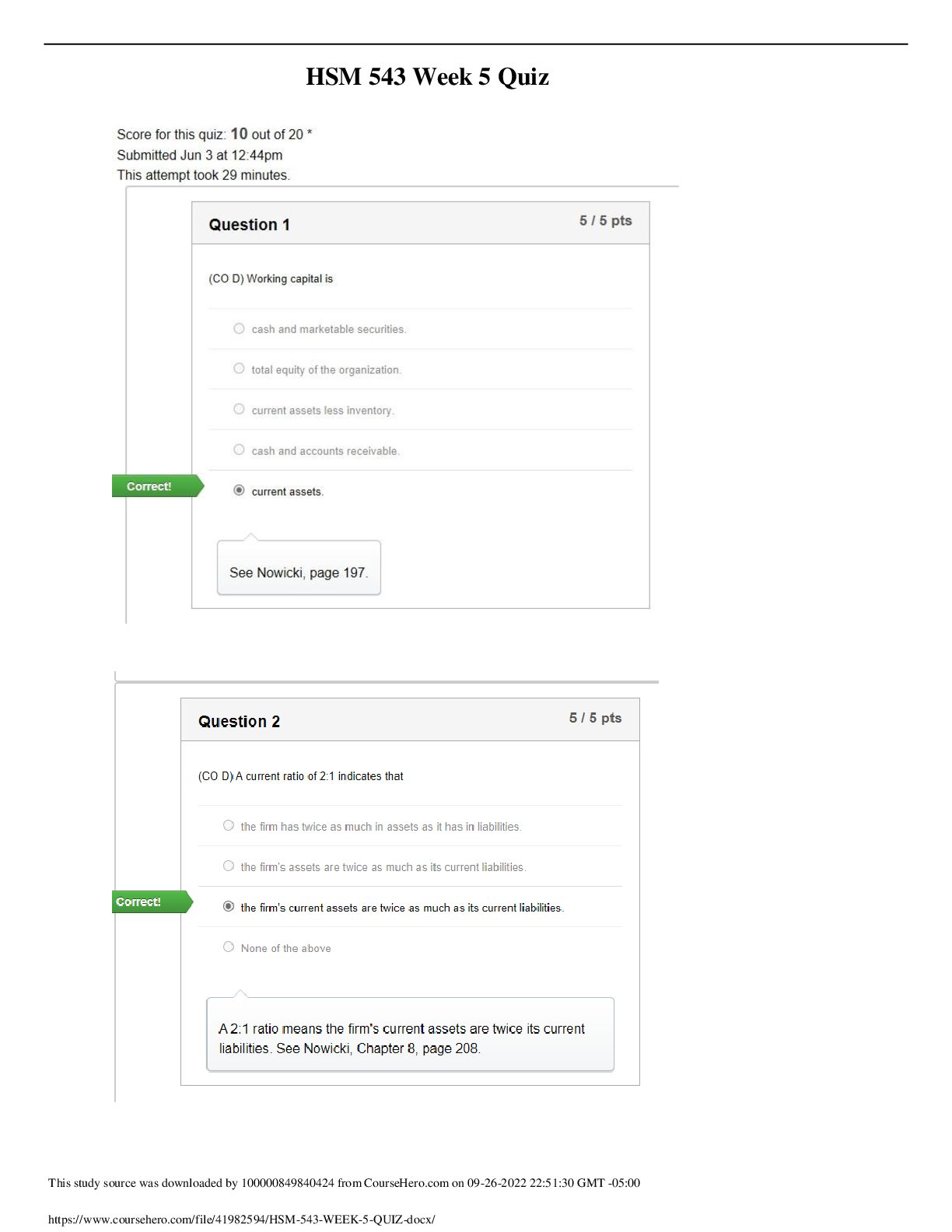
 (1).png)
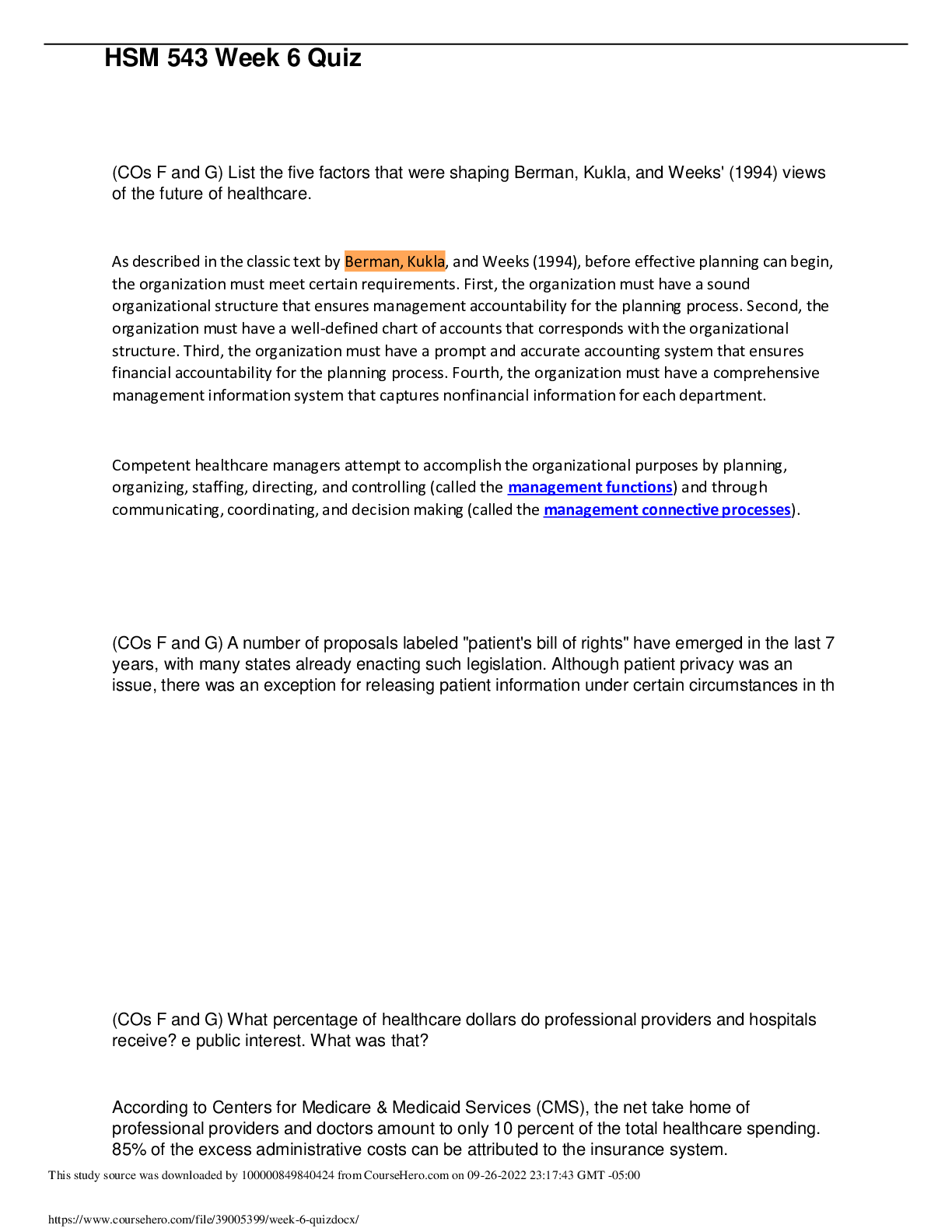
.png)
